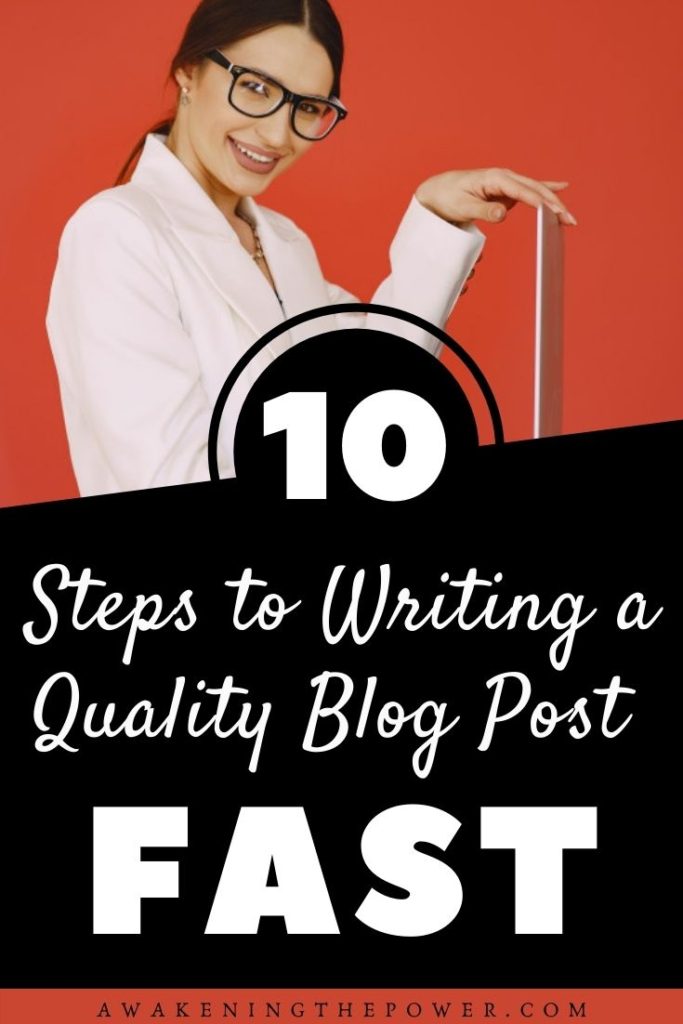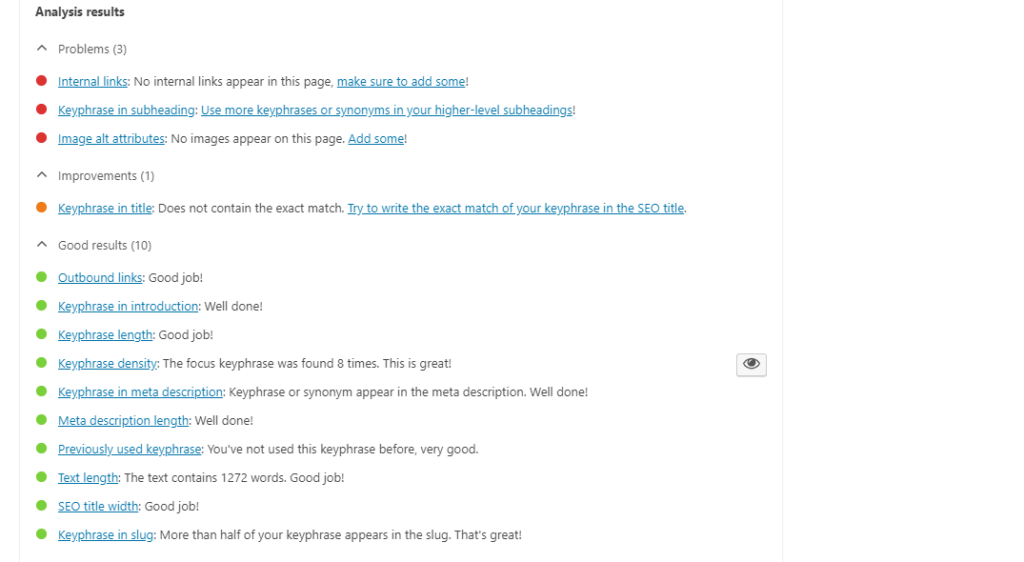Writing a new blog post can feel overwhelming, especially if you’re a newbie blogger.
There are so many things to keep in mind: keywords, SEO, length, readability, etc. Without a trusty roadmap, you might feel lost in this vast blogosphere.
So let me demystify the process for you. Here is a 10-step checklist for writing a blog post that will help you create new content with ease and confidence.
But first…Let’s get a few questions out of the way.
How Often Should You Publish New Posts?
When it comes to blog posts, think: quality over quantity. I cannot stress this enough.
I’ve read some bloggers who recommend writing and publishing a post a day to get your new blog off the ground. That’s crazy to me!
If you’re doing it just to put a checkmark on your to-do list and feel like you’ve been productive today, fine.
But otherwise, it’s a bad idea, and here’s why.
There’s NO WAY you can write “30 in 30” QUALITY posts. It just doesn’t work like this.
The fact is, most of these “rapid-fire” creations are probably not going to be your best work. They’ll populate the site, sure. But they won’t bring you a lot of visitors, and they’ll just be dead weight.
Not only that, they might actually hurt your Google ranking because Google will see your site as spammy or low-quality. So it’s a huge waste of time.

Writing Evergreen Posts
If you’re going to be writing a new blog post, you might as well spend some time and make it “evergreen.”
“Evergreen” posts are quality posts that have what it takes to endure the test of time, and to be popular no matter the season.
They’re written in an easy-to-read format, they offer value to the readers, and they enjoy consistent online popularity.
I have several examples of posts I’ve written years ago that still get thousands of views a day with no additional work on my part.
I’ve spent the time to write them in the beginning. It certainly took more than a day to write each one and to put all the finishing touches on it. Organic traffic took care of the rest. These quality posts require minimal maintenance, and they continue to be big earners year-round.
If You’re a Slow Writer Like Me
I’m kind of a slow writer. I publish no more than 5 new blog posts a month. But those 5 are no sloppy joes! I know that as they mature and gain more authority with Google, they will attract more and more readers.
And because I offer lots of value, they will always be in demand.
That’s how you build a blogging empire — by creating lots of quality posts, and making sure they’re optimized for search engines.
It’s rare that an “inspiration” hits and I bang out a post in one sitting. Usually it takes me a while to come up with an idea, then research it, then write it.
Even if I do everything fast and publish the same day, I’ll still come back to that post several times, to add and edit.
I want my posts to be useful and educational. So even if I know the subject I’m writing about, I still research it to make sure I provide the best possible information to my reader.
My posts are also fairly long. I aim for the minimum of 1,000 words. Most of my posts are actually over 1,500 words.
And then I spend some time on creating several attractive graphics for Pinterest, and getting my posts SEO-ready.
For that reason writing a new blog post can kind of feel like a big undertaking, considering everything that goes into it.
So I came up with a simple check-off system that allows me to write blogs efficiently, without feeling overwhelmed, and at my own pace.
Here’s my tried-and-true 10-step process for writing a new blog post.
10-Step Process For Writing a Quality Blog Post, FAST

1. Come up with the idea.
That’s fairly self-explanatory: to write a new blog post, you need to pick a topic.
Think about your readers and the problem they might have. In marketing this process is referred to as “identifying pain points.” Then come up with a solution for that problem.
Research shows that the most popular types of blog posts are “how to” posts because they solve problems and offer solutions.
2. Narrow down the keywords.
Before you start writing your new blog post, come up with your keywords. This is a crucial step that should never be skipped!
Keywords have to appear in your title, first sentence, subheadings and throughout the text. So it helps to narrow it down from the get-go.
There are many ways to do this. The simplest one is to use Google suggestions. Start typing your topic into a search bar and see what other search terms pop up. Then pick one that’s closest to your topic, or modify your topic if you see the keywords you like better.
Try to come up with long tail keywords, which are 3-4 word phrases that specifically describe your topic. For example, the keywords for this post are “writing blog post.”
Google suggestions is just a way to gage what people are searching for online. It won’t give you any other data, other than the number of search results. If you want to do a more thorough keyword research, try SEO software like Ahrefs and Semrush.
3. Craft an eye-catching headline.
In the blogging world the headline is the most important part of your article. That’s what successful bloggers say.
Some even urge you to spend 80% of your time writing your headline and only 20% on the article itself!
Why is it so important? Because it can boost your traffic and social sharing, or even make your article go viral? Sure, but it’s more than that.
A good headline makes an instant connection with your reader and says: you need to read this NOW.
Here’s a free tool to help you come up with the most enticing, clickable headline: Headline Analyzer. It gives you a score for how appealing your headline is. Rephrase your title and add emotionally-charged words until you come up with a winner.
4. Write introduction and the skeleton.
Now that you’ve got your keywords and title, it’s time for the introduction.
Don’t spend too much time on it, just make sure you mention your keywords in the first paragraph.
Then come up with your bullet points, or the outline of your blog post. It’s like sketching a skeleton before you add all the other parts of the body.
You’re done for now. Walk away from the computer. Take a break.
5. Flesh out the post.
Hey, welcome back! It’s time to finish what you’ve started.
This is when you take your main points, or the outline, and fill in the blanks.
I like to do it with a fresh head because it’s the biggest part of the blog post writing process, and you need to be in your best shape.
Take each bullet point and expand on it. Add numbers or quotes where it makes sense. Provide value. Think about your readers, and what they might find useful.

6. Optimize with Yoast SEO.
I’ve said it before — Yoast SEO is my favorite free WordPress plugin. It makes SEO so simple! You just go through the list, and turn red or orange dots into green ones. It will also help you optimize your post for readability.
Here are some of the things that Yoast will suggest:

7. Add images and graphics.
Blogging is writing for an online audience, and online audiences love visual content.
They appeal to the senses and illustrate the topic of your blog post better than long paragraphs of text.
Ideally, use images with some text on them to highlight your strongest points. And add your keywords to the “alt attributes.”
You can find free high quality images on Pixabay and Unsplash.
Also, aim to create at least 2 Pinterest graphics per post. Experiment with design and wording to see which ones of your pins are doing well, and which aren’t. Then try to replicate the successful ones.
You can use Canva (that’s what I use), Photoshop, PicMonkey, or another design software.
8. Include a call to action.
A call to action is a copywriting term that’s meant to “seal the deal” and move the customer to buy the product.
You’re not selling anything (at least not in the way copywriters do) but you still need to make a personal appeal to the reader, and urge them to take action.
What is the purpose of your post? What do you want them to do?
Maybe you want to inspire someone, or give people the tools to solve a problem.
Maybe you want to start a discussion, or encourage people to share your post with others.
Or maybe you want to redirect your readers to another part of your blog.
Whatever it is, always end with a call to action. Even something as simple as: Leave a comment!
9. Do a final edit.
Editing is best after some time and distance.
So don’t edit the same day you’re writing your post. Do it the next day, or even a few days later.
First, look for grammatical errors or typos.
Then do another edit for readability. Make sure your paragraphs aren’t longer than 2-3 sentences, and that you have enough subtitles.
Finally, read the whole post again. But this time pretend like you’re the audience. Does the post make sense? Is it helpful? Is there a logical and easy flow to it? Are some parts kind of difficult to get through? Re-write or cut them.
10. Share on Pinterest and FB
As a new blogger, you can get too wrapped up in the social media hype. You might spend too much time posting and retweeting, instead of creating stellar new posts.
I’ve been there. So I recommend sticking to the basics: Pinterest and Facebook. Or even just Pinterest. That’s the one social media network that can bring you a ton of traffic with a relatively small time investment on your part.
If you’re interested in minimizing the time commitment even more, I’d go with Tailwind. It’s a Pinterest scheduler that allows you to schedule and share your pins with ease.
It has so many useful features! My favorite feature is board lists. So you can schedule one pin to multiple boards with one click.
If you’re not ready to invest in Tailwind, you can get away with manual pinning. Just keep sharing, and keep experimenting with different pin designs and different times. For example, around 9 am and 7 pm work best for me.
What’s your blog post writing process?
That’s my process for writing a new blog post. What’s yours? Did I miss something? Please share your tips below!
READ NEXT
How to Write an Engaging Opening Sentence For Your Blog Post
10 Simple Ways to Make Your Blog Posts More Reader-Friendly
10 Killer Blog Post Title Templates That Get Clicks, Guaranteed




